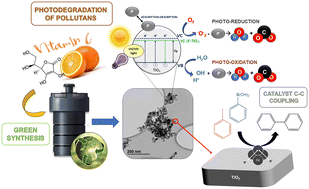Modulation of the photocatalytic activity and crystallinity of F-TiO2 nanoparticles by using green natural carboxylic acids†
Abstract
Ultrareactive F-doped crystalline mesoporous aggregates of titanium dioxide nanoparticles have been synthesized by the acidic hydrolysis of a titanium precursor with different aqueous acidic solutions of organic acids, namely, ascorbic acid (AA), citric acid (CA), benzoic acid (BA) and salicylic acid (SA). The nanomaterials obtained were characterized by different techniques observing, in all cases, that they consist of crystalline mesoporous aggregates of anatase nanoparticles with ultrareactive {001} facets (promoted by F doping) and surface areas of up to ca. 75 m2 g−1. The present study has demonstrated that the use of the “green reagent” ascorbic acid generates titanium dioxide-based systems with superior activity compared with those obtained with other organic acids or HNO3 under the same experimental conditions. The anatase-based nanomaterials obtained when using ascorbic acid are able to photocatalytically degrade up to 92% of a concentrated solution of methylene blue (MB) in 15 min, and common emerging pollutants such as ciprofloxacin and naproxen (87% and 76% degradation, respectively) under UV light (300 W) in 15 min. The photocatalytic activity of the ascorbic acid-promoted systems appears to be associated with differences in the crystallinity of the system promoted by the presence of carbon species on the surface of the material, which are formed even after calcination. Finally, doping the anatase-based nanomaterials with palladium nanoparticles makes them effective heterogeneous catalysts with good to excellent halide conversions (between 60 and 99% for the formation of biphenyl derivatives), yields of up to 40% and a good degree of recyclability in Suzuki–Miyaura C–C coupling at short reaction times and very low loading of Pd.



 Please wait while we load your content...
Please wait while we load your content...